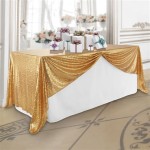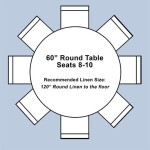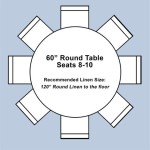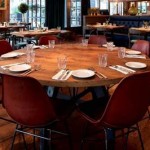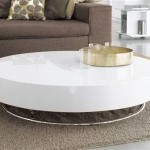Best Size Tablecloth for a 48-Inch Round Table Top
Selecting the appropriate tablecloth size for a 48-inch round table is crucial for both aesthetics and functionality. A well-chosen tablecloth enhances the table's appearance, protects the surface from spills and scratches, and contributes to the overall ambiance of a room. Understanding the factors influencing tablecloth size selection, including drop length, desired aesthetic, and the type of event, is essential for making an informed decision.
The primary consideration when determining the ideal tablecloth size is the desired drop. The "drop" refers to the amount of fabric that hangs over the edge of the table. Different drop lengths create different visual effects, ranging from casual to formal. A shorter drop offers a more relaxed, everyday look while a longer drop conveys a sense of elegance and sophistication. The occasion for which the table is being dressed and the overall design of the room should guide the selection of the appropriate drop length.
To calculate the minimum tablecloth size, consider the table's diameter and the desired drop on each side. For a 48-inch round table, the calculation is straightforward. Add twice the desired drop length to the table's diameter. For example, if a 12-inch drop is desired, the calculation would be 48 inches (table diameter) + 12 inches (drop on one side) + 12 inches (drop on the other side) = 72 inches. Therefore, a 72-inch round tablecloth would achieve a 12-inch drop. This formula provides the basis for selecting a tablecloth size that meets the specific aesthetic and functional requirements.
Understanding Tablecloth Drop Lengths
Different drop lengths serve different purposes and contribute to varying visual effects. The optimal drop length depends on personal preference, the formality of the occasion, and the overall design theme of the space. Common drop lengths include lap length, buffet length, and full length. Each drop length offers a distinct look and feel, making it important to consider the characteristics of each before making a decision.
A lap-length drop typically ranges from 6 to 8 inches. This shorter drop is ideal for casual settings, everyday use, or situations where accessibility to chairs is important. Lap-length tablecloths are less likely to interfere with guests' legs and provide a neat, unfussy appearance. They are well-suited for breakfast nooks, informal dining areas, or outdoor settings. This length is practical and easy to maintain, minimizing the risk of spills or damage to the tablecloth.
A buffet-length drop, typically ranging from 10 to 12 inches, strikes a balance between formality and practicality. This length is commonly used for dinner parties, holiday gatherings, or events where a more polished appearance is desired without the extravagance of a full-length drop. A buffet-length tablecloth provides ample coverage while still allowing convenient access to chairs and preventing excessive fabric pooling on the floor. This drop length is versatile and suitable for a wide range of occasions.
A full-length drop, reaching the floor, offers the most formal and elegant look. This type of drop is typically reserved for weddings, banquets, or high-end events. Full-length tablecloths create a dramatic and luxurious effect, transforming the table into a focal point of the room. However, they also require more attention to detail, as they may need to be adjusted to ensure they do not bunch or drag excessively on the floor. Full-length tablecloths are ideal for creating a sophisticated and unforgettable ambiance.
Choosing between these drop lengths depends largely on the intended use of the table and the desired atmosphere. Weighing the pros and cons of each option will contribute to a decision that complements both the table and the surrounding environment.
Factors Influencing Tablecloth Material Selection
The material of the tablecloth significantly affects its appearance, durability, and maintenance requirements. Different materials offer varying levels of stain resistance, wrinkle resistance, and overall longevity. Common materials include cotton, linen, polyester, and blends. Each material has its own unique characteristics, making it essential to consider the specific needs and preferences when selecting a tablecloth.
Cotton is a natural fiber known for its softness, breathability, and absorbency. Cotton tablecloths offer a comfortable and inviting texture, making them well-suited for casual and everyday use. However, cotton is prone to wrinkling and may require ironing to maintain a crisp appearance. It is also susceptible to staining, particularly from oil-based substances. While cotton tablecloths are relatively affordable, they may not be the most durable option for high-traffic areas or frequent use.
Linen is another natural fiber prized for its elegant drape, natural luster, and durability. Linen tablecloths are often associated with formal occasions and upscale dining. Linen becomes softer and more absorbent with each wash, adding to its appeal. However, linen is also prone to wrinkling and requires careful ironing to achieve a smooth, polished look. Linen tablecloths are typically more expensive than cotton options, reflecting their superior quality and aesthetic appeal.
Polyester is a synthetic fiber known for its durability, stain resistance, and wrinkle resistance. Polyester tablecloths are a practical choice for high-traffic areas and events where spills are likely to occur. Polyester is easy to care for and requires minimal ironing, making it a low-maintenance option. While polyester may not have the same luxurious feel as cotton or linen, it offers excellent value for its durability and convenience. It's an especially good choice for outdoor tables or frequent use.
Blends, such as cotton-polyester blends, combine the best qualities of both fibers. These blends offer a balance of softness, durability, and wrinkle resistance. They are often more affordable than pure cotton or linen options and require less maintenance. Blend tablecloths are a versatile choice for a variety of occasions, providing a practical and aesthetically pleasing solution.
The selection of tablecloth material should be based on the intended use, desired aesthetic, and maintenance preferences. Considering the pros and cons of each material will help ensure that the chosen tablecloth meets the specific needs and requirements.
Color and Pattern Considerations
The color and pattern of the tablecloth play a significant role in setting the tone and enhancing the overall aesthetic of the table setting. Different colors and patterns evoke different emotions and create different visual effects. The choice of color and pattern should complement the existing decor, the occasion, and the desired ambiance. Careful consideration of these factors will contribute to a cohesive and visually appealing table setting.
Solid-colored tablecloths offer a classic and versatile option that can be easily paired with a variety of tableware and decor. Neutral colors, such as white, ivory, beige, and gray, provide a timeless and elegant backdrop that allows other elements of the table setting to stand out. Bold colors, such as red, blue, and green, can add a pop of vibrancy and personality to the table. Black tablecloths create a dramatic and sophisticated effect, particularly for formal occasions. Selecting the right solid color depends largely on the desired mood and the existing color scheme.
Patterned tablecloths add visual interest and can be used to create a specific theme or style. Floral patterns evoke a romantic and whimsical feel, while geometric patterns offer a modern and sophisticated look. Stripes and plaids add a touch of casual charm, while damask patterns create a luxurious and elegant effect. The scale of the pattern should be proportional to the size of the table and the surrounding space. Smaller patterns are generally more versatile and less overwhelming, while larger patterns can make a bolder statement.
When selecting a color or pattern, it's important to consider the existing decor of the room. The tablecloth should complement the colors and patterns of the walls, furniture, and accessories. It's also important to consider the occasion for which the table is being dressed. For formal occasions, subtle and elegant patterns or solid colors are generally preferred. For casual occasions, bolder colors and patterns can be used to create a more relaxed and festive atmosphere.
The color and pattern of the tablecloth should also complement the tableware. Solid-colored tablecloths provide a neutral backdrop that allows patterned tableware to shine. Conversely, patterned tablecloths can be paired with solid-colored tableware to create a balanced and visually appealing effect. Coordinating the colors and patterns of the tablecloth and tableware can create a cohesive and stylish table setting.
Ultimately, the choice of color and pattern is a matter of personal preference and the desired aesthetic. Experimenting with different options and considering the overall ambiance of the space will help in selecting a tablecloth that enhances the dining experience and creates a memorable impression.
In conclusion, the selection of the best size tablecloth for a 48-inch round table involves careful consideration of drop length, material, and color/pattern. Understanding these factors allows for the creation of both a functional and aesthetically pleasing table setting.

Let S Talk Linens The Ultimate Guide To Table Linen Sizes Party Al Ltd Pink Hippo Blog

Tablecloth Size Round

Use This Tablecloth Size Chart For Perfect Party Planning Lovetoknow

Let S Talk Linens The Ultimate Guide To Table Linen Sizes Party Al Ltd Pink Hippo Blog

Tablecloth Size Guide For Square Rectangular Round Tables

Solid Color Polyester Table Linens Royal Settings Llc

Let S Talk Linens The Ultimate Guide To Table Linen Sizes Party Al Ltd Pink Hippo Blog

How To Choose The Right Tablecloth Sizes For Event Tables Linen Als Wedding Table Runners Chair Covers Bbj La Tavola

How To Choose The Right Tablecloth Sizes For Event Tables Linen Als Wedding Table Runners Chair Covers Bbj La Tavola

3 Easy Ways To Measure Tablecloth Sizes Your Table Linens Size Guide
Related Posts


